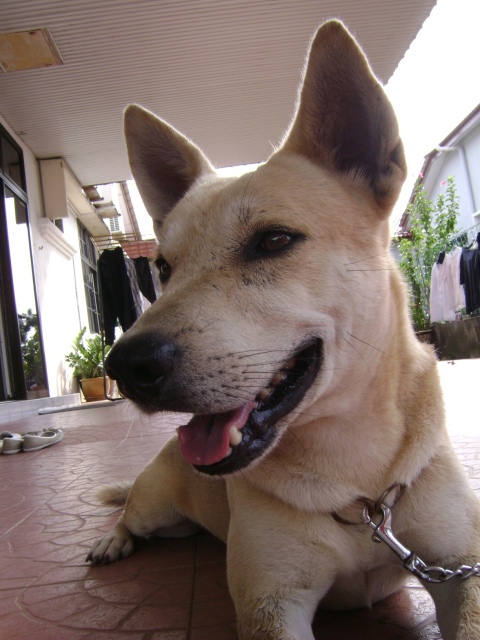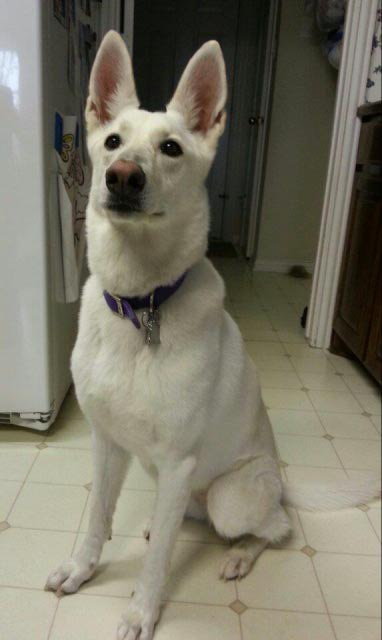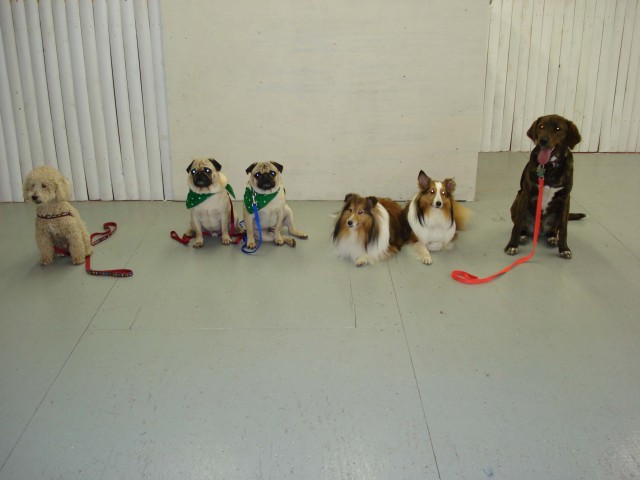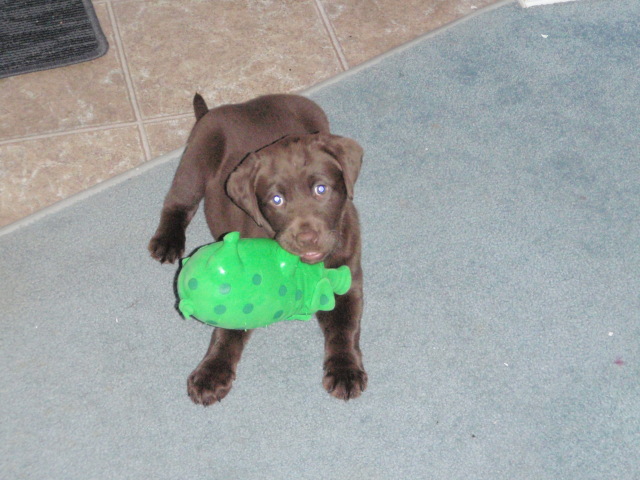QuestionHi Kathleen,
I have 2 Jack Russel x Maltese dogs that are 11 months old, the back story is pretty long but in short. I have had Lily since she was a puppy, Picasso is her brother but my friend bought him at the same time from the same litter. We have recently taken Picasso in because her boyfriend didn't want him and dumped him on the side of the road.
Lily is desexed but Picasso isn't (we plan on doing this soon) since Picasso moved in with us Lily's behaviour has spiralled. Picasso doesn't like our cat, he barks and chases the cat whenever he sees him, Lily has begun to copy this behaviour even though she used to play so nicely with the cat before.
Another problem we're having with Picasso, he barks at people and other dogs when we're out walking or if they come to our house. I have tried blowing a whistle when he does it and other things that make loud noises but he doesn't respond at all to it. Lily is also copying this behaviour although she responds to the whistle.
Please help me.
AnswerThanks for your question.
Here's a link to my web site where you'll find lots of helpful dog information: http://outlawchinooks.com/index.htm
Your new dog sounds a bit reactive and could probably use some redirection to better fit into your home. The Jack Russell part of their mix will be a big contributor to the barking -- they are terriers and like to work in packs, think of it as a job description. After trying some of the leadership skills listed below, you may want to teach the dogs to speak on command so you are able to reward them when they are quiet. Let me know after you've worked on acclimating the pair if that is something you want to try.
Here are some basics to get you started. Good luck and let me know if you have questions after giving these things a go.
Leader of the Pack
Dogs like an interactive leader and these tips will help you and your dog to develop a good working relationship. As you read through the leadership list, think about if you or your dog do two or more of these. If so, your dog is the leader of your pack and you are the Omega. The goal is to help you become a good leader in your home and to help you become a benevolent leader.
Do these sound like your dog?
Plays "catch me" and "chase me" games? (With toys, your cell phone, when they need discipline, to entertain themselves, to avoid going in the crate?)
Bites at your heels, pant leg, hands?
Tries to "hump" you and anyone in your house?
Only listens and obeys when there is nothing else happening?
Urinates or poops on your bed?
Growls or attacks you or refuses to move when you move them from a specific location?
Won't listen when you try to train them to do something new?
Runs over you, your family and your guests?
Is over protective of their toys and food?
Won't come when called the first time or with distractions?
Do you let your dog?
Go upstairs, downstairs and through doorways first?
Eat first?
Sleep in bed with you?
Talk back to you if you try to move them off of the couch, bed, kitchen table?
Jump on furniture any time they want?
Have toys lying all over the house?
Jump on you and everyone else without being given the command "paws up?"
Jump into your vehicle without permission?
Poke at you, bark or steal things to get your attention?
Free feed with food available at all times?
Are you seeing a pattern here? If so, your dog is likely the leader of your pack and you are likely the Omega. You are in the right place to make some changes, put in some hard work and develop the wonderful canine citizen that you want. Your assignment is to establish or regain your leadership position by working with your dog's natural tendencies to appreciate being part of a group or pack. The steps are subtle and will work if you stick with them, but you can't stop practicing once your dog responds. As soon as you forget or get lax, your dog will resume their behaviors and go back to being the pack leader.
Dogs are masters of the slot machine mentality and your dog will continue to test your leadership ability to see if you really say what you mean; in human terms, are you walking the talk. How much testing will lessen over time -- as long as you are being consistent -- and once most dogs get to be about 5-years old the testing rate drops even more.
Leadership Training for You and Your Dog
Take your dog to an obedience class or hire a private trainer to work with the two of you. Make sure to check out any school or trainer you are considering to be certain you are comfortable with their style and training methods. Take the time to go and see how they train and what type of classes are offered. Avoid classes that use treats all the time or coercion all the time as neither of these methods -- used exclusively --will teach you and your dog to work as a team. Ideally, you are creating a dog that wants to work and that makes your dog more reliable and more fun to train.
No Such Thing as a Free Lunch
This is the first step to a healthier relationship with your dog. You will be assuming the leader role in your house and your dog will be learning that the free ride is over and he must earn everything (except water) from this point forward. Those free-for-all petting festivals that your dog enjoys now happen only when you decide and after your dog does something to earn the attention, like doing a sit first.
While you are working on this transition, use both verbal commands and hand signals for the sit. (SIT hand signal: With your right hand palm facing upward, drop your hand below the dog's nose and lift upwards, like you are lifting a weight, toward your shoulder, bending your elbow. Keep your hand about one hand length away from your dog's nose and remember never touch the dog with any hand signal.) Once your dog is sitting, you may pet him. If he gets up, stop petting and ask for the sit again. If the dog doesn't sit on the first request (remember it can take up to 10-seconds for your dog to process your request), ask him to sit and then if you still have no movement, you can lure into the sit. You can also use a leash and collar to help them understand by gently lifting up on the leash so your dog is more likely to lower their rear toward the ground.
How do your voice sound when you are giving commands? Keep in mind that you are giving your dog directions -- like a coworker or a lost driver -- your voice should be calm and steady. If your dog still refuses, fight the urge to yell and instead lower your voice and speak more slowly. This is your chance to reprogram your dog -- and I know you are working diligently on this -- so your dog is now sitting for everything. Picture these scenarios: sit to greet you, sit to greet your guests, sit to be fed, sit for petting, sit before chasing a favorite toy, sit before going inside or outside, sit before getting into the car. Your reward for all this sitting is seeing your dog become more controllable while your naturally take the leadership role, something both of you will like.
Bondage Indoors
Keep a leash on your dog inside for at least the first two weeks and make it like an umbilical cord to your body. You'll know they are improving when they start listening better. At first snap or tie the leash to you; I usually hold the end rather than tie the dog to me -- mostly because I don't want to get wrapped up in the lead. Now you are in charge and your dog will start listening to you while becoming more familiar with the words you use when you want a response from them. (You can use any words you like for commands as long as your are consistent.) Having the dog attached to you also lets you redirect your dog's behavior and correct your dog's mistakes without chasing him all over the house. Once they start improving and becoming more consistent, you can let them drag the leash around the house -- if your balance isn't great, rig up a shorter version so you don't get tripped -- when you are around to supervise. Again, you can correct more easily when the leash is available to step on and stop the chase me games.
Bondage Outdoors
Use a 20-foot or 30-foot long line. (I have been known to use horse lunge lines, long, thin cotton ropes for this. I always wear gloves with the long lines to save from rope burns.) This is a great way to teach your dog to come the first time you ask by teaching him that there is no option but to pay attention to you. Not too hard when they are still attached to you by a long line. Once your dog is familiar with working at a distance from you and has become reliable -- because you are working at this for short periods several times a day -- you can let your dog drag the long line around with them while you supervise. Under your supervision, be sure there are no hidden dangers that the line will get tangled up on and cause damage to your dog. Don't rush through the dragging the line step, take your time to be certain the dog understands all the commands before removing the long line.
Food is Power
Set up a feeding schedule. If you free feed (food available all the time) stop right now. Yes, I can hear you that it is easier for you, but trust me on this one, you need to be in charge of the feeding schedule. The one who controls the food controls the dog. For adults dogs, feed once in the morning and once in the late afternoon or early evening. Dogs are fairly simple beings and are concerned with very few things which mostly consist of eating, sleeping, playing and reproduction. If they can accomplish these things on their own, why do they need you? Setting a feeding schedule (called challenge feeding) teaches your dog he needs to rely on you, creates an appetite so your dog will look forward to feeding and will therefore enjoy the food more and you will be gaining leadership status without working too hard. You can also use feeding time to train your dog, nothing says that all the dog food should be consumed from a dog dish.
You Always Eat First
While you are working on your new relationship with your dog, your dog needs to see you eat before you feed them. What you eat is not important, it is the ritual of eating first that counts. You can eat an ice cube, a baby carrot, green beans, donuts, cookies, fruit, bread, anything works since it is the ritual that is important. (This is not an excuse to fall off the healthy diet wagon in your own life.) Bottom line, your dog needs to see you eat. Leaders always eat first and your dog will understand this no matter what he sees you consume.
Will Work for Food
Have your dog sit before you put the bowl down. Once the dog sits, set the food bowl down. Your dog should wait for your okay before eating. Your dog can't eat unless you have given the go ahead. The word you choose doesn't matter, just use it consistently. (Some choices could be: eat; chow; dinner; feeders.) Make certain your dog really is waiting for the go-ahead to eat. Practice using different lengths of time before allowing your dog to eat.
Table Manners
The instant your dog leaves the food dish, pick it up (even if there is food in the dish) and put it away until the next feeding. (If you are feeding with canned food or wetting the food, ut the food in the refrigerator or throw out the remaining food.) You want your dog to understand that while the dish is down it is time to eat and once he leaves the bowl that dinner is over. This helps create good manners in your dog and is a wonderful subtle way to share your new leadership role.
Toy Collector
Pick up all your dog's toys and place them in a basket or plastic container and then put the container in a closet. From this point forward, you are in control of the toys, and you should only have two toys available at any time. This new system of toy rotation will keep all your toys interesting to your dog. Some houses have dog toys strewn all over the house, which effectively tells you in dog lingo that the entire house is his territory. By gathering up the toys and keeping them, you now control the fun and the house is now your territory and you can allow your dog the privilege of playing when you think it is appropriate. (Toy collecting will also reduce tripping and swearing in the middle of the night.)
Sweet Dreams
If you allow your dog to sleep on the bed with you or be on the furniture with you, you are telling them they are your equal. If they think they are equal to you, their is no hierarchy and makes your new leadership role more challenging for you. As equals, they don't need to listen to you or respect you. Dogs that are well behaved and have no "issues" can sleep with you and be on your furniture, but a dog with "issues" must not be on equal footing with you. If you want to lay down and pet your dog, get on the floor at their level. In their world this is an honor for you to get on the floor with them. When they come up to your level, the dog quickly figures out that they are wonderful and you are pond scum. At this point, playing and cuddling are down on their level. Once you have a reformed and courteous canine, you can invite your pet to come up and play or cuddle. Don't let them on the furniture without an invitation. When you are done playing or cuddling, you ask them to get off and return to their own level.
Up the Down Staircase and Out the Door
Always go upstairs, downstairs and through doors first. At the doorway have your dog sit and wait. You go through the door first and then glance back and say "Let's Go." The same thing applies for up and down the stairs. Use "Let's Go" instead of Come; Come means something entirely different. "Let's Go" means follow me now. Don't turn and face your pet during this training step, just glance over your shoulder and give your command in a cheerful voice.
Walk with Me
During all walks -- including your daily walk of 30- to 60-minutes -- have your dog walk with you in Heel position. (On your left side with their head lined up with your pant leg seam.) Don't let your dog wander all over in front of you, it teaches your dog not to respect your relationship. Walking is a time for you to bond with your dog, to challenge your dog's mind and to teach your dog to walk pleasantly next to your side. A dog that is allowed to race all over ahead of you will always have a problem of pulling on the leash because they remember running all over in front of you. When your dog has progressed far enough that he is almost trustworthy enough to stay by you off leash, you can let them investigate (on leash) every once in a while. From purely an exercise point of view, your dog gets more exercise walking with you, in heel position, then he does pulling on the end of the leash ahead of you.
Walk with Me and Investigate
At some point during your walk, stop in a nice spot, attach your long line or retractable leash (retractable leashes may be harder to control for some people than a long line) to the collar, then unhook and remove your regular leash. Your job is to stand in one place so your dog can check out the radius of the area you are standing in and let them investigate and be a dog. When you are ready to continue walking, call your dog and rehook the regular leash and then take off the long line or retractable and continue your walk. When changing leashes, ALWAYS hook on the line you want to use while the other leash is attached. Both leashes will be connected and you can decide which one you want to remove. This one move will save you from having to chase your dog after they twist out of your grasp.
Your Dog Can Count
If you find yourself repeating commands over and over and not getting the response you want from your dog, you are letting your dog know he is in charge. Don't plead with your dog to do what you ask, ask ONCE and wait for up to 10-seconds for a response. Dogs have excellent hearing so the odds are pretty good the dog has heard you. If you ask for a Sit and get no response, quickly place/lure them into a Sit as you say it one more time. In a clam tone, praise your dog -- the word YES is an excellent way to acknowledge the dog is doing something right and they are quite keen on the "s" sound. If your dog doesn't respond to your request, be sure to assist the dog with the proper response, this way your dog will learn that you mean what you say. The upside of this proactive is the your pooch will stop ignoring you now.
Biting and Nipping are Never Okay
Biting and nipping a person is never okay and is not okay for dogs at any age including puppies. By nipping, biting, mouthing, the dog is learning to dominate you and get you to do what they want you to do. Pups biting their mothers and litter mates are corrected with a growl and depending on the severity the pup might get a snap from mom if he doesn't listen the first time. This is the process dogs go through to learn who they can and can't dominate. Do not slap the dog's nose or grab their mouth and hold it shut, all this does is exacerbate the problem.
To correct this in a simple fashion, you can fill a plant mister spray bottle with water and set it to stream mode. Keep this near you and when your pup tries to bite or nip, give them your best mom dog growly voice and say AAHH! No Bite! (Your AAHH! should sound like a cat cacking up a big hairball.) If pup doesn't back off from biting, spray the full force in the face with the water. When they back off, tell them "Yes," "Good" or "Thank You" in your best giving driving directions voice, then redirect your puppy onto something else like going outside, appropriate chew toy, different location and continue on your merry way. Don't pet or praise at this point or you'll end up right back where you started. If the plain water has no impact, you can add white vinegar or lemon juice to the mix.
You can also buy lemon juice in the plastic lemon from your grocery store. The plastic lemons fit nicely into your hands and is quite portable. Wrap your hand around the ball with your thumb covering the squirt opening. Your dog won't be able to see that you are carrying it, and won't know when you are going to use the lemon, but they will smell that you have the lemon. When your pup nips at you, squeeze the lemon hard, and blast the juice into pup's mouth. While you are blasting, say in your best growly mom dog voice, "AAHH! No Bite!" Just like above, redirect your pup immediately after the lemon juice correction. Once you pup is improving and listening to your words, you can reduce the amount of lemon (you can reuse the lemon balls) or white vinegar in your mixture.
Biting is a serious issue and if you are having problems with this you should consider having a professional evaluate your dog and help you with a training and behavior plan.
My Your Leg is Lovely
Most "humping" activity is dominance related and not of a sexual nature. Dogs of both sexes from puppies to adults will "hump" while trying to be the Alpha. Some dogs will stand still and allow this which lets the other dog know it is okay for them to be dominant. Sometimes the "humpee" will dart out from underneath and try to be the "humper." This tells the dog that they are not okay with someone else being the dominant dog. There are times when dogs are evenly matched and it can lead to a fight. If your dog tries this on you or anyone else stop it immediately. This behavior is not cute, and remember not to laugh or plead in a high pitched voice for your dog to stop. Both of those tell them they are doing something good. Spray them in the face with your training spray bottle and say "NO!" "AAHH!" or "BAD!" in your best deep, growly, mom dog voice. Put your dog in a down-stay for 3-5 minutes, then release them by going over and asking for a Sit and reward good behavior by petting them in a calm manner.
The Bed is Mine
If your dog is urinating on your bed, he is telling you in no uncertain terms that he is dominant and the bed is his territory. If this is happening in your household, keep your dog off the bed for at least 6 months. Keep your bedroom door closed at all times so he can't sneak in there while you aren't looking, and to minimize the battle of the bed. If you want your dog sleeping in the room with you, keep him in a crate/kennel. (You could tether him to the bed on a non chewable 2-3 foot lead to encourage him to sleep on the floor by the bed, but if you get up in the middle of the night, remember the dog is attached to the bed so you don't trip and fall.) If you choose to let pup up on the bed after this period, he should only be allowed on the bed when you invite him up. At any point where you want pup off the bed, he should do so without an attitude or back talk. If you are having difficulty, keep the leash on them and when you ask them to get off the bed, you can reinforce your command by taking the leash and telling pup "Off!" while directing them down off the bed. Tell your dog "Yes," "Good" or "Thank You" when they get off the bed.
Conclusion
These clues will help you establish a leadership role in your pack without having to fight with your dig every step of the way. Remember to be consistent and stick with it even when your dog tests his boundaries. Keep working with your dog using, common sense and fair, humane methods. The bottom line is that you need to be smarter than your dog. <>

 how to train a dog?
Questiondog
QUESTION: hi,I want to ask you,how t
how to train a dog?
Questiondog
QUESTION: hi,I want to ask you,how t
 Designating bathroom area
Question
backyard
I have 2 medium mutts that are both b
Designating bathroom area
Question
backyard
I have 2 medium mutts that are both b
 White German Shepherd Aggression
Question
Chloe
A little background on my dog Chl
White German Shepherd Aggression
Question
Chloe
A little background on my dog Chl
 Male Chesador
QuestionWe have a 8 month old puppy that is more than s
Male Chesador
QuestionWe have a 8 month old puppy that is more than s
 Puppy help!
Question
Roxy!
Hello! I am so glad I found this site:)
Puppy help!
Question
Roxy!
Hello! I am so glad I found this site:)